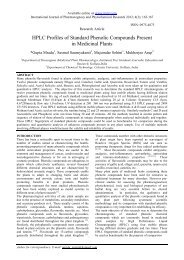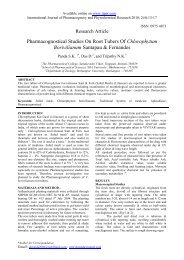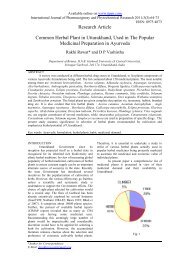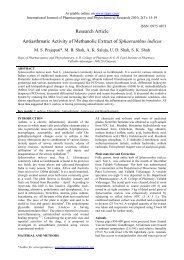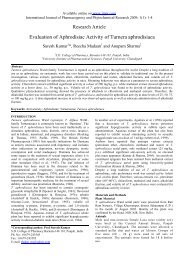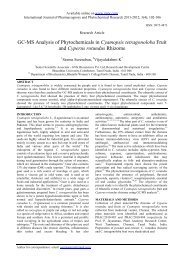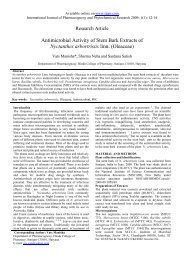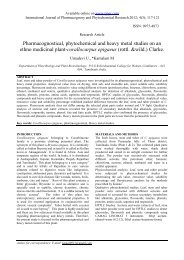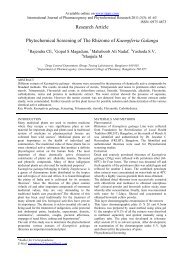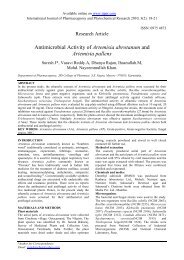evaluation of antibacterial activity of ocimum - International Journal ...
evaluation of antibacterial activity of ocimum - International Journal ...
evaluation of antibacterial activity of ocimum - International Journal ...
You also want an ePaper? Increase the reach of your titles
YUMPU automatically turns print PDFs into web optimized ePapers that Google loves.
Available online on www.ijppr.com<br />
<strong>International</strong> <strong>Journal</strong> <strong>of</strong> Pharmacognosy and Phytochemical Research 2011;3(3): 89-92<br />
ISSN: 0975 4873<br />
Research Article<br />
Evaluation <strong>of</strong> Antibacterial Activity <strong>of</strong> Ocimum<br />
Sneha G, Margaret NJ*, Sastry P, Jyothi Ch<br />
St.Ann’s College for Women, Mehdipatnam, Hyderabad, Andhra Pradesh, India<br />
ABSTRACT<br />
A study was carried out to evaluate the <strong>antibacterial</strong> <strong>activity</strong> <strong>of</strong> Ocimum oil. The oil extracts were prepared using<br />
Clevenger-Hydro-Distillation process. Antibacterial <strong>activity</strong> <strong>of</strong> oil extracts was tested using Disc diffusion method.<br />
Ocimum showed high <strong>antibacterial</strong> <strong>activity</strong>. This was compared against antibiotics routinely used as chemotherapeutic<br />
agents. Our investigations indicated that Ocimum extracts are equally or sometimes more effective as <strong>antibacterial</strong><br />
agents in comparison to antibiotics.<br />
Keywords: Antibacterial <strong>activity</strong>, Ocimum, Antibiotics.<br />
INTRODUCTION<br />
Medicinal plants essentially contain active constituents<br />
that are used in the treatment <strong>of</strong> many human diseases.<br />
The essential oils and extracts <strong>of</strong> plants have been<br />
reported to have an antimicrobial <strong>activity</strong> (3, 7) . Many <strong>of</strong><br />
these plants which show antimicrobial <strong>activity</strong> are used in<br />
Food preparation. They also serve as food preservatives,<br />
examples are spices, turmeric, and basil (8) . The chemical<br />
principle <strong>of</strong> such plants needs to be studied, explored and<br />
exploited.<br />
Even though pharmacological industries have produced a<br />
number <strong>of</strong> new antibiotics in the last three decades,<br />
resistance to these drugs by microorganisms have<br />
increased. Such a fact is cause <strong>of</strong> concern because the<br />
number <strong>of</strong> patients in the hospitals who have suppressed<br />
immunity and new bacterial strains which are multi drug<br />
Table 1: Antibiotic sensitivity tested against E.coli wild<br />
type and drug resistant strains.<br />
Antibiotic (μg)<br />
Streptomycin (25)<br />
Kanamycin (20)<br />
Gentamicin(10)<br />
Tetracycline (15)<br />
Tobramycin (10)<br />
Chloramphenicol(30)<br />
Amikacin(30)<br />
Nalidixic acid (30)<br />
Norfloxacin(300)<br />
Augmentin (30)<br />
Ampicillin (25)<br />
Methicillin (30)<br />
Cephalothin (5)<br />
Cotrimoxazole (25)<br />
Cephalexin(30)<br />
Cephotaxime(30)<br />
Wild strain<br />
zone<br />
inhibition<br />
(mm)<br />
22.6<br />
21<br />
20.1<br />
Resistant<br />
50<br />
32.3<br />
19<br />
Resistant<br />
29.5<br />
40<br />
Resistant<br />
Resistant<br />
Resistant<br />
Resistant<br />
Resistant<br />
40<br />
<strong>of</strong><br />
Resistant<br />
strain<br />
zone<br />
inhibition<br />
(mm)<br />
19.5<br />
11<br />
15.5<br />
17<br />
22<br />
19<br />
21<br />
25<br />
Resistant<br />
Resistant<br />
10<br />
Resistant<br />
Resistant<br />
Resistant<br />
Resistant<br />
Resistant<br />
<strong>of</strong><br />
resistant can result in high mortality (8) . This growing<br />
problem needs to be addressed by providing effective<br />
antimicrobial treatment. Medicinal plants should be<br />
investigated to understand their properties, safety and<br />
efficacy. Our study aimed at finding out <strong>antibacterial</strong><br />
<strong>activity</strong> <strong>of</strong> various Ocimum varieties grown in<br />
experimental fields.<br />
Table 2:<br />
Ocimum ((μg)<br />
OcimumMG Globe<br />
OB Tall<br />
CIM CYU16<br />
Tirupathi<br />
Zone <strong>of</strong> inhibition (mm)<br />
27.6<br />
28.5<br />
28.5<br />
26.5<br />
In present study effectiveness <strong>of</strong> Ocimum as <strong>antibacterial</strong><br />
agent has been evaluated using experimental germplasm<br />
<strong>of</strong> Indian variety. Ocimum oil extracts as antimicrobial<br />
agents is reported along with antibiotics commonly used<br />
as therapeutics. This <strong>evaluation</strong> was carried out to know<br />
the possibility <strong>of</strong> using <strong>ocimum</strong> oils as effective therapy<br />
against multidrug resistant nosocomial bacterial agent in<br />
combination with antibiotics.<br />
MATERIALS AND METHODS<br />
Essential oil from Ocimum - test sample.<br />
The Ocimum species belongs to the Lamiaceae family<br />
includes annual and perennial herbal plants, as well as<br />
shrubs from tropical and subtropical zones <strong>of</strong> Asia, Africa<br />
and South America. These plants are widely spread in the<br />
world.<br />
The most species <strong>of</strong> Ocimum genus are usually named<br />
common basil or sweet basil, is a herbal, annual and<br />
allogamous plant with extraordinary culinary and<br />
medicinal properties. Studies have established that<br />
compounds have antioxidant, anticancer, antiviral,<br />
antimicrobial properties. It is characterized by<br />
considerable morphological and biochemical variability.<br />
In general, a remarkable intra-specific variation exists in<br />
plant morphology and in essential oil composition.<br />
Mostly these essential oils are volatile and aromatic with<br />
antimicrobial, antifungal and antioxidant property.<br />
*Author for Correspondence<br />
E-mail: margaret_nje@yahoo.com
Sneha et.al. / Evaluation <strong>of</strong> Antibacterial…………<br />
Table 3: Antibiotic sensitivity tested against<br />
Staphylococcus aureus wild type and drug resistant<br />
strains.<br />
Antibiotic ((μg)<br />
Penicillin (1 unit)<br />
Amoxycillin<br />
Vancomycin<br />
Neomycin<br />
Cloxacillin<br />
Tetracycline<br />
Amikacin<br />
Gentamicin<br />
Erythromycin<br />
Novobiocin<br />
Bacitracin<br />
Clindamycin<br />
Trimethoprim<br />
Cotrimexazole<br />
Fusidic acid<br />
Wild strain<br />
zone <strong>of</strong><br />
inhibition<br />
(mm)<br />
23.5<br />
Resistant<br />
18<br />
27<br />
Resistant<br />
33<br />
28<br />
32<br />
28<br />
24<br />
10<br />
42<br />
Resistant<br />
Resistant<br />
21<br />
Resistant<br />
strain<br />
zone<br />
inhibition<br />
(mm)<br />
20<br />
Resistant<br />
15<br />
22<br />
Resistant<br />
22<br />
21.5<br />
25<br />
21<br />
22<br />
08<br />
30<br />
24<br />
24<br />
21<br />
Leaves and inflorescences, fresh stems <strong>of</strong> Ocimum<br />
species used in this work were harvested from plants at<br />
full flowering stage from the experimental field. The<br />
extraction <strong>of</strong> essential oil was done using a Clevengerhydro-distillation<br />
process, with a plant material: water<br />
ratio being 1:3, at 60-70° C in 3 hours <strong>of</strong> extraction time.<br />
The anhydrous sodium sulphate was added to remove the<br />
moisture. The extracted oil is stored in glass tubes with<br />
tight lids and kept under refrigeration.<br />
Antimicrobial testing<br />
Table 4:<br />
Ocimum (μ g ) Inhibition Zone<br />
(mm)<br />
Ocimum Globe<br />
Ocimum OGM<br />
Ocimum Kushmohak<br />
Ocimum Tirupathi<br />
MG BD BDL<br />
34<br />
51<br />
27<br />
34<br />
41<br />
Bacterial strains used:<br />
Two test cultures <strong>of</strong> bacteria were used namely<br />
Escherichia coli and Staphylococcus aureus. Escherichia<br />
coli; a Gram negative bacterium is a leading nosocomial<br />
pathogen, causes Urinary tract Infections<br />
(9) .Staphylococcus aureus, a Gram positive bacterium,<br />
causes wound and skin infections.<br />
Pure cultures obtained from National Collection <strong>of</strong><br />
Industrial Microorganisms (NCIM), NCL, Pune were<br />
used.<br />
Maintenance <strong>of</strong> Cultures:<br />
The organisms are maintained on Nutrient agar (HI-<br />
Media, India) slopes at 4°C and sub cultured before use.<br />
Determination <strong>of</strong> <strong>antibacterial</strong> <strong>activity</strong>:<br />
1. In vitro <strong>antibacterial</strong> <strong>activity</strong> <strong>of</strong> essential oils <strong>of</strong><br />
<strong>ocimum</strong> varieties was studied against two<br />
bacterial cultures using Agar diffusion disc<br />
<strong>of</strong><br />
method (2) .<br />
2. The <strong>antibacterial</strong> <strong>activity</strong> <strong>of</strong> known antibiotics<br />
was also tested along with the <strong>ocimum</strong> essential<br />
oils for comparison.<br />
3. Muller – Hinton medium was used for test assay.<br />
4. The extracts i.e. essential oils were diluted to<br />
give 200, 400 and 800µg/100 microliter<br />
concentration.<br />
5. The overnight broth <strong>of</strong> the inoculum was seeded<br />
on the agar plates (1.5 x 10 8 CFU/ml)<br />
6. The solvent used for preparation <strong>of</strong> essential oil<br />
solution was ethanol. Solvent control well was<br />
run for every assay.<br />
7. All the plates were incubated at 37°C for24 hrs.<br />
8. The antimicrobial spectrum <strong>of</strong> the extract was<br />
determined in terms <strong>of</strong> zone sizes around each<br />
well i.e. diameter <strong>of</strong> inhibition zones. Each<br />
result is a mean <strong>of</strong> three replicates.<br />
RESULTS<br />
Medically important plant species <strong>of</strong> Ocimum were<br />
cultivated under experimental conditions in Andhra<br />
Pradesh, India. Essential oils obtained were tested for<br />
their antimicrobial effect. The study was carried out in<br />
comparison with the antibiotics used routinely. A Gram<br />
negative bacterium Escherichia coli and a Gram positive<br />
bacterium Staphylococcus aureus were the test cultures.<br />
Both these bacteria are leading nosocomial agents which<br />
cause infections like UTI and wound infections (5) .<br />
Antibiotics commonly used against them are broad<br />
spectrum belonging to protein synthesis inhibitor and cell<br />
wall inhibitor groups (5) .<br />
Table 1 shows the results <strong>of</strong> antibiotic sensitivity invitro<br />
<strong>of</strong> E.Coli, against 16 different antibiotics. E. Coli NCIM<br />
strains used were wild and drug resistant variety. Agar<br />
diffusion method showed wide zones <strong>of</strong> inhibition<br />
surrounding the antibiotic discs indicating sensitivity to<br />
that particular antibiotic. Comparative study <strong>of</strong> two<br />
varieties were carried out using antibiotics like<br />
Gentamicin, Amikacin, Tetracycline, Tobramycin as well<br />
as antimicrobial agents like Norfloxacin, Nalidixic acid<br />
and others as listed in Table. 1.<br />
E. coli has been reported to show multidrug resistance.<br />
Our results in concurrence showed that wild type<br />
responded well to antibiotics than the drug resistant type<br />
(Fig.1a).<br />
E.Coli wild type was sensitive to antibiotics like<br />
Tobramycin with a zone <strong>of</strong> inhibition with 50mm<br />
diameter while Drug Resistant strain has a zone <strong>of</strong><br />
inhibition <strong>of</strong> only 17mm.<br />
Table 2 shows results <strong>of</strong> sensitivity <strong>of</strong> different Ocimum<br />
oil extracts against E.coli wild type and drug resistant<br />
strains. E.coli wild type showed highest sensitivity for<br />
Ocimum MG Globe variety with inhibition zone <strong>of</strong><br />
28mm. (Table 2) OcimumCIM variety could inhibit<br />
E.coli drug resistant strain and diameter <strong>of</strong> zone <strong>of</strong><br />
inhibition was 27mm which was more than any <strong>of</strong> the<br />
antibiotics tested. This proves effectiveness <strong>of</strong> Ocimum<br />
essential oil used in this study. This is in concurrence<br />
IJPPR September - November 2011, Volume 3, Issue 3 (89-92) 90
Sneha et.al. / Evaluation <strong>of</strong> Antibacterial…………<br />
with the reports that Ocimum has extremely good<br />
antimicrobial <strong>activity</strong> (10) .<br />
Table 3/Figure 3 and 4 show results <strong>of</strong> in vitro test <strong>of</strong><br />
sensitivity <strong>of</strong> Staphylococcus aureus against commonly<br />
used antibiotics. Staphylococcus aureus wild and<br />
antibiotic resistant strains were tested against 16 different<br />
antibiotics. Staphylococcus being Gram positive the<br />
choice <strong>of</strong> antibiotics for testing included cell wall<br />
inhibitors like penicillin and amoxicillin as well as other<br />
broad spectrum drugs. Staphylococcus aureus is another<br />
leading pathogen in hospital environments. It causes<br />
sepsis and skin infections. There are several reports <strong>of</strong><br />
multidrug resistant Staphylococcus aureus. (MRSA).(9)<br />
Our study indicated that staphylococcus wild and drug<br />
resistant strains were sensitive to Clindamycin,<br />
Neomycin, Gentamicin and Tetracycline. In<br />
contradiction to the reports that Staphylococcus<br />
responds to beta lactum antibiotics well (5, 12) our study<br />
indicated high resistance to drugs like amoxicillin,<br />
Cloxacillin ( Fig 3 ). It confirms emerging trend <strong>of</strong><br />
MRSA. It is a matter <strong>of</strong> concern that antibiotics which<br />
worked well are <strong>of</strong> no use today. This can be correlated to<br />
the reports <strong>of</strong> indiscriminate use <strong>of</strong> antibiotics. Therefore<br />
our results <strong>of</strong> Ocimum oil extracts showing promising<br />
inhibitory action against same resistant strains are<br />
encouraging. (13) (Fig4).<br />
DISCUSSION<br />
Escherichia coli and Staphylococcus aureus test cultures<br />
are known to be the leading pathogens in nosocomial<br />
infections (5, 9) . Recent reports indicate that these same<br />
pathogens are showing alarming levels <strong>of</strong> resistance<br />
against commonly used antibiotics (14) . In view <strong>of</strong> this<br />
threat our study brings out the following facts.<br />
Firstly our study confirms the high degree <strong>of</strong> <strong>antibacterial</strong><br />
<strong>activity</strong> <strong>of</strong> Ocimum. Another important finding this study<br />
brought out is when E.coli and Staphylococcus cultures<br />
namely wild and drug resistant strains were subjected to<br />
same antibiotics, wild strains though were more sensitive<br />
to same antibiotics showed resistance to others. This<br />
confirms emergence <strong>of</strong> antibiotic resistance as reported<br />
by several workers. Gram positive bacteria like test<br />
culture Staphylococcus are known to be more sensitive to<br />
ß lactam antibiotics like Penicillin group. Development<br />
<strong>of</strong> resistance to these antibiotics in our study is in<br />
concurrence with the reports <strong>of</strong> Multi Drug Resistance <strong>of</strong><br />
Staphylococcus aureus (14).<br />
IJPPR September - November 2011, Volume 3, Issue 3 (89-92) 91
Sneha et.al. / Evaluation <strong>of</strong> Antibacterial…………<br />
Further this study brought out the comparison <strong>of</strong> Ocimum<br />
oil with commonly used antibiotics as therapeutic agents<br />
using these test cultures. Findings indicated that Ocimum<br />
oil had equal or more <strong>antibacterial</strong> effect to that <strong>of</strong><br />
antibiotics used commonly. Drug resistance strains <strong>of</strong><br />
E.coli and Staphylococcus aureus also were very highly<br />
sensitive to Ocimum oil.<br />
Ocimum oil worked better as <strong>antibacterial</strong> agent against<br />
Gram positive culture i.e. Staphylococcus than Gram<br />
negative test culture i.e. Escherichia coli. This<br />
substantiates the use <strong>of</strong> Ocimum oil and extracts for<br />
septic wounds, skin and wound infections in Traditional<br />
Indian therapies like Ayurveda (3, 8, 12) .<br />
Our findings are significant in context with present day<br />
drug resistance problem as it indicates combined therapy<br />
as an answer for reducing drug resistance. This study<br />
also forms a good basis for selection or these germplasms<br />
<strong>of</strong> Ocimum for further phytochemical and<br />
pharmacological investigations. Effective biomolecules<br />
from such medicinal plants have to be identified and<br />
extensively tested so that they can be used as sources <strong>of</strong><br />
new drugs.<br />
REFERENCES<br />
1. AnjariaJ,ParabiaM.J,Dwivedi.S.J. Ethnovet<br />
Heritage- Indian enthnoveterinary medicine- An<br />
overview,PathikEnterprise, Ahmedabad,<br />
2002.<br />
2. Bauer A.W, Kirby W. M.M, Sherris<br />
J.C.,TurekM.Antibiotic susceptibility testing by<br />
a standardized single disk method. American<br />
<strong>Journal</strong> <strong>of</strong> Clinical Pathology1966; 45: 493-496.<br />
3. ChitravadivuC,ManianS,KalaichelviK.Antimicro<br />
bial studies on selected medicinal plants,Erode<br />
region, Tamilnadu, India.Middle East <strong>Journal</strong> <strong>of</strong><br />
scientific Research2009; 4 (3) : 147-152.<br />
4. Collee G, Duguid J.P,Fraser AG, Marmion<br />
P.Practical medical microbiology, 13 th edition,<br />
Churchill , Living stone,1984.<br />
5. Geo F.Brooks, Janet S. Butel, Stephen A.<br />
Morse.Jawetz Medical Microbiology,Mc Graw<br />
Hill publication,2004.<br />
6. HamnerK.A,CarsonC.F,RileyJ.V. Antimicrobial<br />
<strong>activity</strong> <strong>of</strong> essential oils and other plant extracts.<br />
<strong>Journal</strong> <strong>of</strong> Applied Microbiology1999 ;( 6): 985-<br />
990.<br />
7. Jigna Parekh,Sumitra Chanda.In vitro<br />
<strong>antibacterial</strong> <strong>activity</strong> <strong>of</strong> crude methanol extract<br />
<strong>of</strong> wood fordia fruticoss kurz flower (Lythrceae).<br />
Brazilian <strong>Journal</strong> <strong>of</strong> Microbiology 2007; 38:<br />
204-207.<br />
8. Jigna Parekh, Sumitra Chanda Antibacterial and<br />
phytochemical studies on twelve species <strong>of</strong><br />
Indianmedicinal plants. African <strong>Journal</strong> <strong>of</strong><br />
Biomedical Research 2007; 10(2):175-181.<br />
9. Kenneth J. Ryan, George Ray C. Sherris<br />
Medical Microbiology, 5th edition, Mc Graw<br />
Hill Publishers, 2010, 771-778.<br />
10. Monica Chessborough. Medical Laboratory<br />
Manual for tropical countries,volume 2,<br />
ELBS,1984.<br />
11. Perez C., Paul M., Bazerque P. An antibiotic<br />
assay by the agar well diffusion method. Acta-<br />
Bio Med Exp 1990; 15: 113-115.<br />
12. Rabe J,Van Stadin V .J. Antibacterial <strong>activity</strong> <strong>of</strong><br />
south African plants used for medicinal<br />
purposes. <strong>Journal</strong> <strong>of</strong> ethno pharmacology1997;<br />
56: 81-87.<br />
13. VL,Ctrinck A.J,Van Ho<strong>of</strong> L, Totie J, Lasure<br />
A,Vanden Berghe.D, Rwangobo . D.C,<br />
Moukiyuniwami J. Screening <strong>of</strong> Munored R<br />
Wandese medicinal plants for antimicrobial and<br />
antiviral properties.<strong>Journal</strong> <strong>of</strong><br />
Ethnopharmacology1995; 46:31-47.<br />
14. Westh.H, ZinnC.S, RosdahlV.T. Sarisa Study<br />
Group. An <strong>International</strong> multicentre study <strong>of</strong><br />
antimicrobial consumption and resistance in<br />
staphylococcus aureus isolated from 15 hospitals<br />
in 14 countries. Microbial Drug Resistance2004;<br />
10:169-176<br />
15. Antibacterial <strong>activity</strong> <strong>of</strong> essential oil from<br />
<strong>ocimum</strong> gratissiumum on Listeria<br />
monocytogenes Internet <strong>Journal</strong> <strong>of</strong> food safety, 2<br />
(7): 15-19.<br />
IJPPR September - November 2011, Volume 3, Issue 3 (89-92) 92



